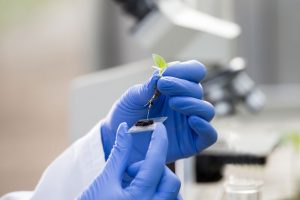Can corn fertilize itself? Can wheat? Many years ago, in the mid-1970s, I was attending a National Wheat Growers convention and listening to a speech by the director of USDA agricultural research. He was talking about what we can expect in the future of wheat breeding. I was half-listening when he got my full attention. My mind’s eye can still clearly see him at the podium as he declared, “What if, in the future, we can get the wheat plant to make its own nitrogen? Think it’s impossible? Hang on to your hat!” I had no idea what he was talking about. Genetic engineering was not yet in my vocabulary.
Though genetic engineering has brought us remarkable advances in crop, weed, and pest management, the dream of transferring the ability of legumes to use nitrogen from the air to other crops has so far proven futile. The symbiotic relationship with Rhizobium bacteria that allows legume plants to accomplish this feat involves a lot of genes in both plant and Rhizobium to work together in a complicated dance. Working out that relationship is ongoing, but getting it done in the near future is unlikely.
Other ways to accomplish the same purpose are also ongoing in many laboratories around the world. You may have read about the corn from Mexico that fertilizes itself. In the 1980s a scientist from the Mars Company (yes, candy bars Mars), Howard-Yana Shapiro, was looking for landraces with reported possible nitrogen-fixing abilities in remote areas of Mexico where corn has been grown for centuries. He found what he was looking for growing in a small indigenous village in the Sierra Mixe region of Oaxaca. The corn grew 16 to 20 feet tall on poor soil without added fertilizer. It had above ground “roots” (called brace roots in normal corn) covered in a sticky, sugary mucus that, in subsequent examination, was found to contain a rich supply of diazotrophic (nitrogen fixing) bacteria.

After years of field and laboratory studies using radioactive nitrogen, a team of scientists led by Alan Bennett of the University of California, Davis, proved that the microbiota in the aerial roots were supplying 30 percent to 80 percent of the nitrogen requirements of the host plant. The landrace is not suitable for U.S fields, as it requires eight months to mature. But it is only a matter of time until this trait is incorporated into U.S. hybrids.
There are other ways some plants get nitrogen from the atmosphere. Some rice farmers have fertilized their paddies for centuries by growing a companion plant, the fern Azolla, which harbors a cyanobacterium that can live and produce ammonia in specialized leaf cavities of the fern. Some rice varieties harbor a bacterial endophyte that can fix nitrogen and supply it to the plant. (An endophyte is a bacteria or fungus that lives inside the plant, either benignly or parasitically.)
Lots of grasses harbor endophytes, and many of them aid plant survival in some way, such as enhancing drought survival. Engineering one to infect wheat plants and supply nitrogen to the plant is a possibility.
Another target of plant engineers is the mitochondria and chloroplasts of plants. These organelles are thought to have originated from bacteria that were absorbed into a symbiotic relationship with single-celled eukaryotic (cells with a nucleus) ancestors of plants eons ago. These (probably parasitic) eukaryotic cells provided a secure home and the chloroplasts to work absorbing energy from the sun and storing it as sugars. The mitochondria broke down those sugars and made energy available to run cell machinery. The former parasitic cell was now self-sufficient, and, using energy from the sun, colonization of the Earth began.
These organelles have their own DNA, independent of the nuclear DNA, and their genes function in similar ways to bacteria. This makes them more receptive, in theory anyway, to genetic alterations to include genes from diazotrophic bacteria that could give a plant the ability to make its own nitrogen. Cyanobacteria, one of the earliest life forms on earth and the probable inventor of photosynthesis, is the suspected ancestor of chloroplasts. Often called blue-green algae, there are about 2,000 species and some are diazotrophic.
A number of companies are working on microbial products that can be applied as a seed treatment and subsequently colonize the roots in a symbiotic relationship where roots leak carbohydrates into the soil to feed bacteria or fungi that fix nitrogen for plant uptake. Root-mycorrhiza associations are common, but not always benign. Through genetic engineering these associations can be greatly enhanced to provide nutrients and other benefits, such as drought tolerance.
Making ammonia and getting it on the land for fertilizer uses 2 percent of the world’s energy and 3 percent to 5 percent of world natural gas production (6,7). The Haber-Bosch process invented in the early 1900s, using steam at high pressure to take nitrogen from the air and hydrogen from natural gas to make ammonia, presently feeds about one-half of the world’s population. Whether we like it or not, approximately one-half of the nitrogen in our bodies was synthetically produced. In his book, The Alchemy of Air, Thomas Hager states that “If we all ate simple vegetarian diets and farmed every acre of arable land as wisely as possible using the best techniques of the late 1800s, the earth could support a population of around four billion people,” or about one-half the present population. The energy to produce all that nitrogen fertilizer presently comes from fossil fuels and pumps billions of tons of carbon dioxide into the atmosphere. We have to do better. If we can engineer plants to make at least some of their nitrogen perhaps, we can use renewable energy sources (wind, solar, hydro) to make the rest through electrolysis.
Jack DeWitt is a farmer-agronomist with farming experience that spans the decades since the end of horse farming to the age of GPS and precision farming. He recounts all and predicts how we can have a future world with abundant food in his book “World Food Unlimited.” A version of this article was republished from Agri-Times Northwest with permission.



